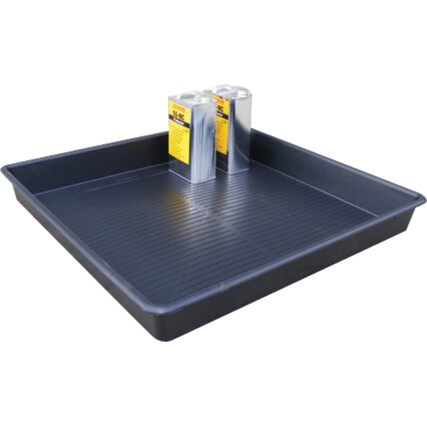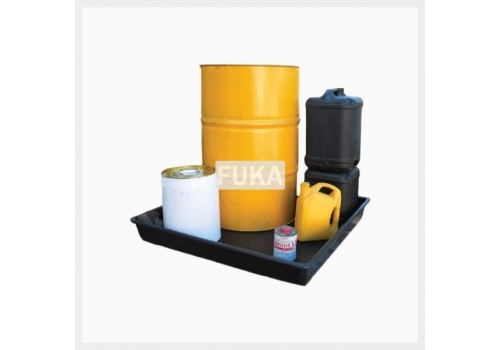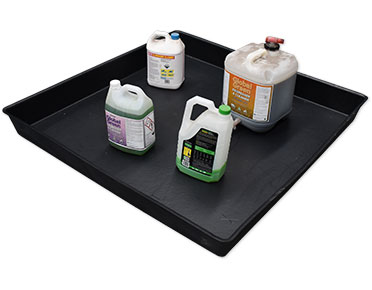
Product
Chemical Spill Tray
Chemical Spill Tray is one essential tool in workplaces where chemicals, oils, or hazardous liquids are handled; safety and environmental protection are top priorities.
**Price quoted including professional advice.
Please call/SMS/whatsapp
*******Free Quotation*******
017-641 2290
Chemical Spill Tray
size: 1000x1000xH120mm, 110L
size: 1000x550xH150mm, 75L
size: 570x385xH50mm, 10L

Functions, Benefits, and Applications
In workplaces where chemicals, oils, or hazardous liquids are handled, safety and environmental protection are top priorities. One essential tool used to achieve this is the chemical spill tray. This simple yet effective containment solution is designed to prevent leaks, spills, and drips from contaminating work surfaces, floors, or the environment. Whether in laboratories, factories, warehouses, or workshops, chemical spill trays play a crucial role in safety management. This article explores what chemical spill trays are, their types, benefits, and how to choose the right one for your workplace.
What is a Chemical Spill Tray?
A chemical spill tray is a specially designed container or shallow platform made from chemical-resistant materials, used to hold containers of liquids and prevent accidental leaks or spills from spreading. It acts as a secondary containment measure, catching any drips, leaks, or overflows before they can cause damage, injuries, or environmental hazards.
These trays are commonly made from polyethylene (PE), polypropylene (PP), or stainless steel, depending on the type of chemicals they need to handle. They are lightweight, durable, and resistant to corrosion, making them suitable for a wide range of industrial and laboratory applications.
Importance of Using Chemical Spill Trays
In many industries, chemical handling is part of daily operations. However, even with careful handling, accidents can happen. A small leak from a container can damage surfaces, release harmful fumes, or even cause slip hazards. A chemical spill tray provides a proactive safety measure by containing the spill immediately, minimizing cleanup time and preventing workplace accidents.
Additionally, environmental regulations in many countries require businesses to have adequate spill containment measures to prevent contamination of soil, drains, and waterways. Using spill trays helps companies stay compliant with these regulations while maintaining a safe workplace.
Types of Chemical Spill Trays
Chemical spill trays come in various shapes, sizes, and materials to suit different workplace needs:
-
Standard Flat Spill Trays – Low-profile trays with flat bases, ideal for placing under small containers, chemical bottles, or laboratory glassware.
-
Deep Containment Trays – Designed with higher sidewalls to contain larger spills, suitable for use under drums or larger chemical containers.
-
Modular Spill Trays – Units that can be linked together to create a larger containment area for multiple containers.
-
Grated Spill Trays – Feature a removable grating on top, allowing containers to sit above the spill area while drips and leaks are collected underneath.
-
Specialty Spill Trays – Designed for specific chemicals or unique applications, such as acid-resistant trays for handling corrosive substances.
Materials Used in Chemical Spill Trays
The choice of material depends on the type of chemical being stored or handled:
-
Polyethylene (PE) – Highly resistant to most acids, bases, and oils. Lightweight and suitable for a wide range of chemicals.
-
Polypropylene (PP) – Offers excellent resistance to organic solvents and high temperatures.
-
Stainless Steel – Strong and durable, ideal for flammable liquids and situations requiring high mechanical strength.
-
PVC or Composite Materials – Often used for specific chemical resistance or cost-saving purposes.
Benefits of Chemical Spill Trays
Using chemical spill trays provides several advantages for businesses and workers:
-
Prevents Environmental Contamination – Catches spills before they reach drains or soil.
-
Improves Workplace Safety – Reduces slip hazards and exposure to harmful substances.
-
Easy Cleanup – Spills are contained in one area, making cleanup faster and more efficient.
-
Cost Savings – Prevents costly damage to floors, equipment, and storage areas.
-
Regulatory Compliance – Meets safety and environmental regulations for spill control.
-
Versatility – Can be used in laboratories, industrial plants, workshops, and even at home for safe storage of chemicals.
Applications of Chemical Spill Trays
Chemical spill trays are used in a wide range of industries and situations:
-
Laboratories – To hold reagent bottles, acids, solvents, and other hazardous liquids during experiments.
-
Manufacturing and Industrial Plants – For storing lubricants, cleaning agents, paints, and other liquid materials.
-
Warehouses – To place under stored drums or intermediate bulk containers (IBCs) to catch leaks.
-
Workshops and Garages – For containing oil drips, coolant spills, and other automotive fluids.
-
Chemical Transport – Spill trays can be used as portable containment during chemical delivery or transfer.
Choosing the Right Chemical Spill Tray
When selecting a chemical spill tray for your workplace, consider the following factors:
-
Chemical Compatibility – Ensure the tray material is resistant to the chemicals you are handling.
-
Capacity – The spill tray should be able to hold at least 25% of the total stored liquid volume, or more if required by regulations.
-
Size and Shape – Choose a tray that fits the storage area and accommodates all containers without crowding.
-
Portability – Some trays are lightweight and easy to move, ideal for temporary setups or mobile workstations.
-
Durability – Look for high-quality construction that can withstand long-term use without cracking or degrading.
Maintenance and Best Practices
To ensure chemical spill trays remain effective and safe:
-
Inspect regularly for cracks, wear, or chemical damage.
-
Clean trays after each spill using suitable cleaning agents compatible with the tray material.
-
Keep trays dry when not in use to prevent corrosion or microbial growth.
-
Avoid overloading trays beyond their designed weight or liquid capacity.
-
Train staff on proper use and spill response procedures.
Compliance and Safety Standards
Many countries have strict regulations for the storage and handling of hazardous liquids. Organizations such as the Occupational Safety and Health Administration (OSHA) in the United States and local environmental authorities in Malaysia outline requirements for spill containment. Following these standards not only ensures legal compliance but also protects employees, customers, and the environment.
In some cases, chemical spill trays are part of a larger spill control plan, which includes spill kits, absorbents, and personal protective equipment (PPE). By integrating spill trays into your safety program, you create a multi-layered approach to hazard control.
Sustainability Aspect of Spill Trays
High-quality chemical spill trays can be reused for many years, reducing the need for disposable containment solutions. Many polyethylene trays are recyclable at the end of their life, supporting sustainability goals and reducing waste. Additionally, by preventing chemical leaks into the environment, spill trays contribute directly to environmental conservation.
We cover most area in Klang Valley as below:
-Selangor-Alam Impian,Ampang,Ampang Botanic,Ara Damansara,Balakong,Bandar Botanic,Bandar Bukit Tinggi,Bandar Kinrara,Bandar Puteri Klang,Bandar Saujana Putra,Bandar Sunway,Bandar Sungai Long,Bandar Utama,Bangi,Banting, Batang Berjuntai,Batang kali,Batu Arang,Batu Caves,Beranang,Bukit Jelutong,Bukit Rahman Putra,Bukit Rotan ,Bukit Subang,cheras,Country Heights,Cyberjaya,Damansaraa Damai,Daman Intan,Damansara Jaya,Damansara Kim,Damansara Utama,Denai Alam ,Dengkil,Glenmarie,Gombak,Hulu Langat,Hulu Selangor,Jenjarom,Kajang,Kayu Ara,Kerling,Klang,Kota Damansara,Kota Emerland,Kota Kemuning,Kuala Langat,Kuala Selangor,Kuala Kubu Baru,Kuang,Mutiara Damansara,Nilai,Petaling Jaya,Port Klang,Puchong,Puchong South,Pulau South,,Pulau Indah,Puncak Jalil,Putra Heights,Putrajaya,Rasa,Rawang,Sabak Bernam,Saujana,Selayang,Semenyih,Sepang,Serdang,Serendah,Seri Kembangan,Setia Alam,Setia Eco Park,Sierra Mas,SS2,Subang Bestari,Subang Heights,Subang Jaya,Sungai Buloh,Sungai Pelek,Taman TTDI Jaya,Tanjong Karang,Tanjong Sepat,Teluk Panglima Garang,Tropicana,Ulu Klang,Usj,Usj Heights.
-Kuala Lumpr-Ampang Hilir,Bangsar,Brickfields,Bukit Bintang,Bukit Jalil,Bukit Ledang,Bukit Persekutuan,BukitTunku,Cheras,City Centre.Country Heights,Country Heights Damansara,Damansara,Desa Pandan,Desa Park City,Desa Petaling,Gombak,Jalan Ipoh,Jalan Klang Lama,Jalan Kuching,Jalan Sultan Ismail,Jinjang,Kenny Hills,Kepong,Keramat,Kl City,Kl Sentral,Klcc,Kuchai Lama,Mont Kiara,Old Klang Road,Oug,Pandan Indah,Pandan Perdana,Pandan Jaya,Pantai,Pekan Batu,Salak Selatan,Segambut,Sentul,Seputeh,Serdang,Setapak,Setiawangsa,Solaris Dutamas,Sri Dutamas,Sri Hartamas,Sri Petaling,Sungai Besi,Sungai Penchala,Taman Desa,Taman Duta,Taman Melawati,Taman Tun Dr Ismail,Titiwangsa,Upm,Tpm,wangsa maju.
We also cover whole Malaysia, Johor, Penang, Melaka, Batu Berendam, Seremban, Negeri Sembilan, Malacca, Sabah, Sarawak, Kedah, Pahang, Kelatan, Terengganu, Perlis, Perak, Taiping, Ipoh, Kemaman, Skudai, Senai, Ulu Tiram, Pontian, Kulai, Johor Bharu, Masai, Nusajaya, Batu Pahat, Segamat, Muar, Seberang Prai, Pulau Pinang, Butterworth, Kuantan, Penang, Melaka, Nilai, Senawang,


